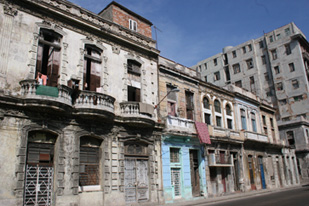
Havana
A city with two distinct faces – one for the tourists and one for the locals.
 |
| The Old City’s once palatial Spanish-built houses are crumbling |
This week on 48 Amanda and the crew experience life in Havana, a city with two distinct faces – one for the tourists, and one for the locals.
An elaborate system of different currencies and licenses allows the country to reap the rewards of tourism, whilst encouraging foreign visitors not to stray from a pleasant, government-approved vacuum.
In this 48, Amanda Palmer breaks the seal and talks to Havana’s locals about life in one of the few communist countries to have survived into the 21st century, despite the best efforts of some of the world’s most powerful nations.
Last July Fidel Castro, who has led the country since the fall of the US-backed dictatorship of Fulgencio Batista in 1959, underwent life-threatening surgery. Months of intense speculation about the 80-year-olds health ensued, and there were suspicions about the authenticity of the regular videos released by the government to assure them of Castro’s improving health. He temporarily ceded power to his brother Raul, and many beyond Cuba’s beaches anticipated an end to the maverick regime. However, in a recent article Castro declared he is on the mend, and colleagues insist it is only a matter of time before he resumes office.
 |
| Eccentric local artist Fuster adorns the houses of his neighbourhood with mosaic art |
Old Havana is the first destination and where Amanda meets nurse and legal tourist rickshaw driver, Pepe.
The Cuban authorities are cautious about foreign film crews – here news and television are heavily censored – but even armed with the relevant journalist permits, the crew is stopped and questioned five times in the first hour of filming. But Pepe’s tour persists regardless; he is eager to show Amanda everyday life in the Old City.
The once palatial Spanish-built homes, which are literally crumbling, are causing a serious housing issue in the Old City. The government is restoring them, but with so many other priorities for funding, it is a slow process. In the meantime its residents must move or bide their time amongst the rubble.
Food rations and sporadic power and water are also everyday realities, and many Cubans work illegally to supplement their state incomes. The Cubans Amanda meets have mixed feelings – some blame the flaws of Castro’s leadership or the limitations of communism, but many also see 46 years of US embargoes as the root of the country’s problems.
 |
| Cubans playing dominoes in the street |
Over the next two days Amanda’s local guides introduce her to Fidel Castro’s vision of a perfect society. Seeing culture as the ideal balm for a country in withdrawal from capitalism, he has massively funded the development of Cuba’s home-grown art, dance, music and sport.
Amanda meets the eccentric local artist Fuster, who transforms his talents and socialist ideals into public property by adorning his neighbourhood’s houses with elaborate mosaic art.
Baseball is a national obsession in Cuba, and the country has nurtured some of the world’s best players. A night trip to Havana’s largest stadium gives an insight into why the people – and Castro himself – feel so passionately about the sport.
‘Danza Voluminosa’, a ballet troupe for those of ample figure, proves that dance is something that spawns from the souls of all Cubans, regardless of their size and after a session with a band of young Hip Rock musicians, the crew is swept into the heaving crowds of an open-air salsa party.
Whatever the hardships of everyday life, the Cuban spirit lives on.
Watch this episode of 48 here:
https://www.youtube.com/watch?v=kc1Bee1nCFg
https://www.youtube.com/watch?v=i2SJCrKuRXw
This episode of 48 aired from 09 June 2007